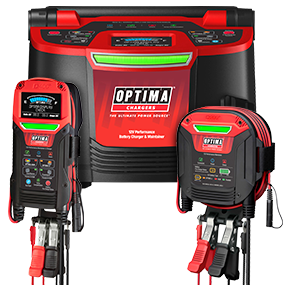-
A battery is just a battery. Right?
Wrong!
The sophistication and number of automotive electronics are drastically increasing. Whether it's original equipment or the accessories you've added, you're drawing more power from your battery than ever before. Choosing the right OPTIMA battery will help you keep the tunes playing, the lights on and the engine starting.
OPTIMA batteries are the choice among performance enthusiasts who want to add more power to their adventures. Thanks to proprietary SPIRALCELL & PUREFLOW TECHNOLOGY®, these batteries are up to 15 times more vibration-resistant, which means they can take a lot of abuse both on and off the road, and provide up to three times the life of a traditional flooded battery.
OPTIMA's AGM battery grids are constructed of 99.99% pure lead. The purity of the lead provides lower internal resistance for additional power and quicker recharging, corrosion resistance for longer life and reduced self-discharge when stored on the shelf.
The case straps that connect the cells are far more robust than the tombstone welds commonly found in most other batteries. Those robust connections allow for better transfer of energy, both when you're charging your battery and when you need it to deliver power.
OPTIMA's Absorbent Glass Mat (AGM) separators hold electrolyte like a sponge to eliminate acid spilling. Each maintenance-free battery is also completely sealed, preventing corrosion and acid spills.
When it comes to lithium batteries, OPTIMA is one of the most-respected and established names in the battery industry. Since we are a battery manufacturer, as well as a brand, that means we have a deep, first-hand understanding of what goes into manufacturing a great battery. We employ engineers who work full-time on making sure all of our batteries are the best possible products on the market. We also make sure our lithium batteries offer features we know you want, even if you didn't realize you needed them, including an integrated BMS (Battery Management System) and IP67-rated protection from dust and water intrusion. -
-Do I need to use the included POWERLINK dongle with ORANGETOP Powersports Batteries?
Yes. POWERLINK™ must be connected to activate your ORANGETOP Powersports battery after installation. POWERLINK™ is also critical for the battery to work properly and to take advantage of the advanced functionality this system offers. Without POWERLINK connected, you will be unable to wake the battery from sleep mode or reactivate the battery to utilize the OPTIMA CPR built-in jumpstart functionality.
-Can I use a regular battery charger to charge an ORANGETOP?
OPTIMA® Chargers with lithium charging profiles were designed to function as a system with OPTIMA® Lithium Batteries to ensure maximum safety, service life, performance, functionality and convenience.
CautionLead acid chargers/charge profiles are not optimized for charging lithium batteries and could result in subpar performance, reduced battery life or property damage.
Use only chargers or charging profiles specifically designed for 12V lithium iron phosphate (aka LFP or LiFePO4) batteries.
Do not use:
-Lead acid battery charging profiles.
-Chargers/charging profiles for flooded/SLI batteries, AGM or gel batteries.
-Chargers/charging profiles with a desulfation/antisulfation/reconditioning mode or function. Although this can be useful for lead-acid/AGM batteries, it may cause a lithium battery to be overcharged.Your battery will not be fully charged when received. You must fully-charge the battery to 14.0V before use. You may need to "wake" the ORANGETOP battery either through the POWERLINK dongle on Powersports batteries or the on/off button on other ORANGETOP batteries
-Do I need to buy an OPTIMA lithium enabled battery charger (such as an OPTIMA D200+) to charge an ORANGETOP?
OPTIMA® Chargers with lithium charging profiles were designed to function as a system with OPTIMA® Lithium Batteries to ensure maximum safety, service life, performance, functionality and convenience.
OPTIMA ORANGETOP lithium batteries will automatically wake from Sleep/Storage mode for charging if an OPTIMA lithium-enabled charger is used. If using a non-OPTIMA charger, it may be necessary to manually “wake” the battery using the POWERLINK™ button with ORANGETOP Powersports batteries or the on/off button on other ORANGETOP batteries.
Non-OPTIMA Chargers:
- Can only be connected to the battery terminals for charging.
- Only chargers or charging profiles for 12V lithium iron phosphate (aka LFP or LiFePO4) batteries should be used. The charger/profile should use a CCCV (constant current, constant voltage) charge profile and operate at 14.3-14.5V and discontinue output when the battery is fully charged.
- Should not exceed the maximum charging current limits of the battery terminals as noted in the “Technical Specifications” section of the user manual.
-Recommended Applications / Can I use an ORANGETOP Powersports battery in a car, truck or boat?
- ORANGETOP Powersports batteries are designed for engine starting in powersports applications (including side-by-sides, motorcycles, 4-wheelers, etc...) and are not warrantied for automotive use
- We have done limited ORANGETOP testing in non-powersports applications
- While the ORANGETOP QUAD30 has started every vehicle we have tested, we haven't tested every vehicle and we haven't tested below 50°F.
- The energy storage capacity of the ORANGETOP Powersports battery may be ¼ to 1/5 an OE car/pick- up battery. This means that typical car or truck key-off loads could result in a “dead” battery in less than a week in those applications.
- OPTIMA CPR (built-in jump start) may or may not reserve enough power to start cars or trucks, depending on the demands and temperature
- Consider that access to the POWERLINK to reactivate the battery or utilize OPTIMA CPR built-in jump start may be difficult, if the vehicle is un-powered.
- The ORANGETOP Powersports battery has high cranking power, but low capacity/energy storage when compared to a typical automotive battery. As such, it is not recommended for high- demand audio or vehicles/applications with high accessory loads
- The ORANGETOP Powersports battery is not designed or warrantied for motive power applications (where batteries make the vehicle move) - hoverboards, ebikes, golf carts, etc.
- Do not connect more than two (2) batteries in parallel. Connecting more than two (2) batteries in parallel may cause permanent damage to the battery or reduced service life.
- Do not connect batteries in series (24v, 36v, etc.).
WarningParallel connections should only be done with batteries of the same size, type/technology and age or reduced service life and performance will result. Parallel connections must be made with the batteries at equal levels of charge or sparks or explosion could occur. All connections must have appropriate circuit protection via fuses, circuit breakers or similar current protection devices. Do not connect in series.
-Can I user jumper cables on an ORANGETOP?
Jumper cables can be used, but if the ORANGETOP maximum current specifications as noted in “Technical Specifications” are exceeded during the use of jumper cables, the ORANGETOP may return a fault.
-What is the warranty term for an ORANGETOP?
The warranty on ORANGETOP batteries is 60 months, free replacement for non-commercial use and 12 months free replacement for commercial use. Automotive use is not covered for ORANGETOP Powersports batteries-Where can I get warranty service for an ORANGETOP?
Original purchasers of the ORANGETOP are automatically enrolled in HYPERCARE enhanced service, directly with OPTIMA. OPTIMA HYPERCARE is your exclusive option for service and support. Other OPTIMA or battery retailers do not have the capability to diagnose and support technical evaluation or service for the ORANGETOP.
-What is the fully-charged voltage of an ORANGETOP?
100% state of charge (SoC) of ORANGETOP is 14.0V
-Is it ok to fully-charge the ORANGETOP?
The ORANGETOP does not have a “memory effect” from partially or fully charging Although some lithium batteries do have some level of reduced performance or life from being fully charged or stored in a fully charged state, OPTIMA HYPERCORE LITHIUM does not have this limitation.
-If you deeply-discharge an ORANGETOP, does it make it wear out faster?
Deeply discharging any battery, regardless of chemistry or technology, will cause some reduction in overall service life. Generally, for lithium batteries including the ORANGETOP, discharging to a 0% state of charge (SoC) only a few times will have an imperceptible effect on overall life.
It is important to keep in mind though, that severe over-discharge (below 0% SoC) can cause permanent and unrecoverable damage to any battery, including lead-acid, lithium and the ORANGETOP. ORANGETOP batteries have multiple layers of protection to help prevent and protect against discharge below a 0% SoC.
ORANGETOP Powersports batteries are not recommended for deep-cycle applications or applications where normal or expected use of the battery would include deep-discharge cycling.
-Were the materials in the ORANGETOP responsibly sourced?
Although cobalt (used in some lithium batteries) is not formally listed as a conflict mineral, there are questions about the ethical extraction and trade of this material. The OPTIMA ORANGETOP does not use a cobalt-based lithium chemistry.
-Does an ORANGETOP work in cold temperatures?
As with all batteries, extreme cold temperatures will result in reduced performance. Cold- weather performance is best when the ORANGETOP is fully charged.
The ORANGETOP will automatically deactivate charging when internal temperatures are below 23°F (-5°C) and will deactivate power output below 14°F(-10°C).
When temperatures are below 32°F (0°C), applying a load to the battery will cause the internal temperature to increase slightly and can improve cold-weather performance. Successive starting attempts may have more power than the initial attempt for this reason. Turning on the headlights for up to five (5) minutes will often increase the internal temperature enough to be beneficial in this regard.
The OPTIMA Q31M-DP120 ORANGETOP can be charged down to 32°F and can operate down to -4°F. The OPTIMA Q31M-DC150 ORANGETOP batteries can operate down to -4°F and have an integrated cell heater, that will allow them to accept a charge down to -22°F.-Is an ORANGETOP Powersports battery sensitive to heat?
Storage and use at excessive temperatures can reduce battery life. Using heat shields or installing the battery away from excessive heat sources, such as exhaust headers or components is recommended.
At higher temperatures, the length of engine cranking events available may be less than five (5) seconds and the “cooldown” time needed between attempts may be longer than three (3) seconds. Charging and use of the battery is disabled if the internal temperature exceeds thresholds noted in the “Technical Specifications” section of the user manual.
-Can I charge an ORANGETOP Powersports battery without the POWERLINK dongle?
The OPTIMA ORANGETOP Powersports battery will automatically wake from Sleep/Storage mode for charging if an OPTIMA lithium-enabled charger is used via the POWERLINK dongle. If using a non-OPTIMA charger, it may be necessary to manually “wake” the battery using the POWERLINK dongle connected to the ORANGETOP Powersports battery.
-
REDTOP Starting Battery
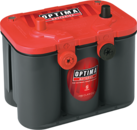
REDTOP Starting Battery: Use this for normal engine starting where an alternator immediately monitors the state of charge and provides energy to the battery whenever it is needed. This would describe most stock vehicles.
Also use for:
- Automotive and RV under-hood starting
- Heavy equipment where starting is the primary function
- Diesel-powered vehicles with no aftermarket electronics
YELLOWTOP Deep-Cycle Battery
.png?sfvrsn=d023e48c_1)
YELLOWTOP Deep-Cycle Battery: Use this when electrical loads are higher than average, or when the discharge cycle is more than typical engine starting, such as vehicles without alternators. This also includes vehicles with significant electrical loads that may exceed the average alternator output (for example, aftermarket audio systems, dash cams, GPS, chargers, winches, snowplows, inverters, drag cars). This can also include vehicles that have a lot of electronics from the factory, such as a minivan with power sliding doors and a DVD player, especially if the DVD player is used when the engine isn’t running.
Also use for:
- Racing vehicles without a charging system (alternator or generator)
- Dedicated drag-racing vehicles
- Diesel-powered vehicles with aftermarket electronics
- Car audio/video applications exceeding 250 watts over the OE system
- Vehicles or heavy equipment with inverters, hydraulics, winches or other accessories
- Electric vehicles
Where can I get pucks or other adapters for my battery?
All new REDTOP batteries (except the 6-volt battery) and all new YELLOWTOP batteries (except the DH5, DH6 & DH7, Group 51, DS46B24R, 27 & 31) come with a variety of trays, pucks and other fitment adapters. If your battery did not come with this set of adapters, please contact our customer service team at info@optimabatteries.com and be sure to have your original retailer's contact information handy.
BLUETOP Marine Battery
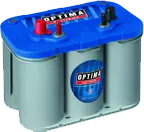
BLUETOP Marine Battery: The BLUETOP starting battery (dark gray case) is to be used when a dedicated starting battery is required; it should never be used for cycling duty. The dual-purpose BLUETOP (light gray case) can be used for both starting and deep cycling; it is a true deep-cycle battery with extremely high cranking power.
Also use for:
- Trolling motors, marine applications with heavy electrical accessories and RVs should use a dual-purpose BLUETOP (which is both a starting and deep-cycle battery)
- Marine applications and RVs when the battery’s only function is engine starting
Note: The difference between BLUETOP and YELLOWTOP deep-cycle batteries is that BLUETOP batteries have both automotive (SAE) posts and threaded studs, while YELLOWTOPS (other than D31T) only have SAE terminals.
If you ever get confused about the colored tops, just remember: If it has a dark gray case, then it’s a starting battery; if it has a light gray case, then it’s a deep-cycle (dual-purpose) battery.
-
When selecting a battery, engine starting performance or cold-cranking amps (CCA), and size obviously matter, but there are other considerations. Where and how you use your vehicle and the electronic load that your battery supports should be considered. Energy recovery and cycling performance are also quickly becoming important considerations. In some applications, they are even more important than CCA.
OPTIMA REDTOP - A Starting Battery with Serious Power
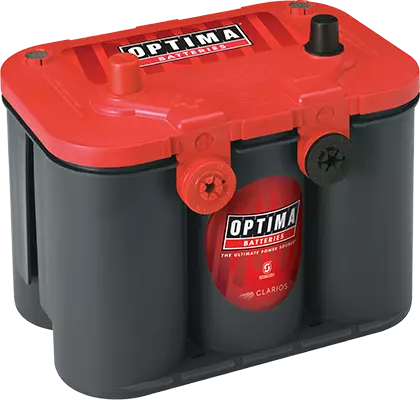
An OPTIMA REDTOP is perfect for starting applications where your vehicle's engine requires high amperage output in short bursts. The discharge cycle is shallow and the alternator takes over after the battery starts your car. Daily drivers love the REDTOP, as do drivers of classic cars, show cars and SUVs.
OPTIMA YELLOWTOP - Dual-Purpose Deep-Cycle Battery to Power Electronics and Start Your Engine with Power
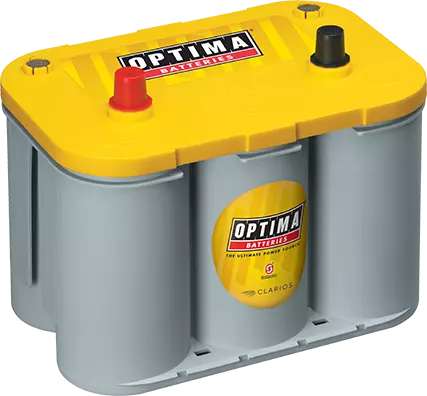
If you're looking for a reliable battery for starting your vehicle and to support a load of electronic accessories, including winches and audio systems, an OPTIMA YELLOWTOP deep-cycle battery is the right choice. The YELLOWTOP battery is also ideal in vehicles that don't have an alternator or have electrical demands that temporarily exceed the alternator's output. It helps meet those high electrical demands until you're able to recharge.
YELLOWTOP batteries provide deep-cycle power. This allows you to enjoy all of your electronic accessories while your vehicle is off, such as audio systems, DVD players or underbody lights. For off-roaders, your battery will allow you to winch your way out of precarious situations. There are also a number of key-off draws that pull energy from your battery, including dash cams, alarm systems, digital radios (station settings) and onboard computer systems. You'll be able to pull all of this power from your YELLOWTOP with the confidence that your battery's energy will recover time after time. -
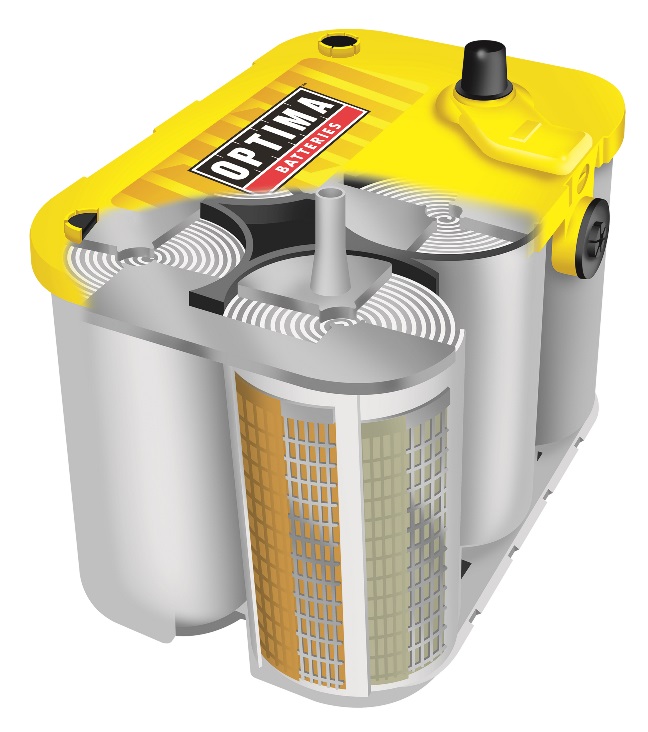
The OPTIMA SPIRALCELL TECHNOLOGY® provides many features not available in ordinary batteries, such as:
- More plate surface, closer plate spacing and the use of high-purity lead. RESULTING IN: Low internal resistance. This low resistance gives you more power in a smaller box, the ability to recharge much faster, and higher and cleaner voltage characteristics during discharge.
- Immobilized plates under compression (locked in place). RESULTING IN: Improved vibration resistance, no shedding of active paste material, reduced gradual loss of power and capacity as the battery ages. This gives you a battery that lasts longer and performs better throughout its life.
- OPTIMA's SPIRALCELL design results in about 30 internal components, where traditional flat-plate batteries can have more than 120 internal parts. One of OPTIMA's internal components is a continuous cast strap, which joins adjacent cells & eliminates welds, which add resistance and corrosion points between the cells. A cast strap is unique to OPTIMA, proprietary, more expensive and more difficult to manufacture, but it is a design that offers superior performance. A larger and/or better-designed, manufactured or connected strap will allow better high-current flow, due to lower internal resistance, which can be reflected in the CCA rating.
-
For technical or warranty support, please call OPTIMA customer service at 1-888-867-8462 (888-8OPTIMA) between 9 a.m. and 5 p.m. (CST) Monday through Friday, or via email at info@OPTIMAbatteries.com.
For Amazon.com OPTIMA warranty Support, contact:
E-mail: Amazonwarranty@OPTIMAbatteries.com
Toll Free: 888-8-OPTIMA or 888-867-8462
** Please have the following information ready for faster service:
-Customer Name on the Amazon.com account used to purchase the OPTIMA product
-Customer Email on the Amazon.com accnout used to purchase the OPTIMA product
-Invoice -
The main reasons the OPTIMA battery has a longer life are:
- There is no shedding of active paste material
- The SPIRALCELL TECHNOLOGY® immobilizes the plates, preventing the active paste from working loose, which can cause plate-to-plate shorting
- It utilizes a high-purity lead grid
- The grid material in OPTIMA batteries is more resistant to grid degradation – a type of internal corrosion that affects the plates inside a battery as it ages
- The completely sealed design prevents loss of water, which can lead to plate dry-out and failure
OPTIMA batteries have increased ability to withstand the high demands being placed on batteries today, including high-heat situations, heavy electronic loads and increased vibration. The SPIRALCELL TECHNOLOGY® in an OPTIMA battery is what keeps it from shedding active material that gives a battery power. This technology also extends an OPTIMA battery’s cycling ability.
-
Mostly this is due to the purity of the lead in the plates of OPTIMA's AGM SPIRALCELL and PUREFLOW batteries. Some of the alloys in conventional batteries are more prone to electron transfer, resulting in higher self-discharge than is found in an OPTIMA AGM battery.
-
A gel battery design is typically a modification of the standard lead-acid automotive or marine battery. A gelling agent is added to the electrolyte to reduce movement inside the battery case. Many gel batteries also use one-way valves in place of open vents, which help the normal internal gasses to recombine back into water in the battery, reducing gassing. Generally, gel batteries are less tolerant of high heat and are charged at lower power than traditional or AGM (Absorbed Glass Mat) batteries. An OPTIMA AGM battery is neither a gel battery nor a regular flooded battery. OPTIMA's AGM batteries are a SPIRALCELL or PUREFLOW battery technology.
-
When used with a properly regulated constant voltage charging system (such as an alternator), an OPTIMA AGM battery will not emit hydrogen gas. However, gassing can occur when charging at excessive voltage levels or in extreme high-temperature conditions. In automotive applications, this typically will not happen if the alternator/regulator stays below 15 volts.
-
WHAT DOES DEEP-CYCLE MEAN?
For lead-acid batteries, deep-cycle means using the battery in an application that will typically discharge 60% to 70% or more of the battery capacity. A standard automotive battery is an SLI (starting, lighting and ignition) battery. Its plates are designed to deliver maximum power for a short duration. Starting a car typically discharges an SLI battery less than 5 percent. When an SLI battery is used in a deep-cycle application, or in a vehicle with heavy accessory loads, the battery life will be shortened proportionally to how deeply it is cycled on a regular basis.
WHEN SHOULD I CONSIDER A DEEP-CYCLE BATTERY?
Anytime you need the battery to supply all the operating power for a vehicle or other device. Additionally, deep-cycle batteries should be used in vehicles that have heavy accessory loads where the alternator cannot maintain the battery in a fully charged condition. Some examples include vehicles with powerful stereo systems, vehicles with increased electronics like GPS, game systems, DVD players and LCD screens, dash cams or boats with onboard chargers, trolling motors, fish-finders, stereos, lights, etc.
DOES AN OPTIMA DEEP-CYCLE BATTERY HAVE A “MEMORY?”
Lead-acid and lithium batteries do not suffer from memory effect. That is primarily an issue limited to NiCad batteries. Many people think they have a memory because they experience a reduction in capacity or runtime as the battery ages. The active paste material in a lead-acid battery is a consumable item, similar to tread on a tire. Every time you cycle the battery, some of the paste is used up. As the battery ages, less of the active paste is available to charge and discharge, resulting in a reduced operating time. This situation can be more apparent in the case where a high-power or starting, lighting and ignition (SLI) battery is used in a deep-cycle application. The plates of an SLI battery are designed for high-current, short-duration discharges. Plates in deep-cycle batteries are better suited to repetitive deep-discharge applications.
HOW DOES A GEL CELL COMPARE TO YOUR DEEP-CYCLE?
Most gel batteries have much higher internal resistance, meaning they will not be able to deliver and receive current as efficiently. This is especially apparent at higher amperage levels. For example, most gel batteries will not work successfully in engine-starting applications.
-
WHAT’S THE DIFFERENCE BETWEEN AN OPTIMA® AGM DEEP-CYCLE AND STARTER BATTERY?
The OPTIMA deep-cycle AGM (Absorbed Glass Mat) battery utilizes different chemistry. This chemistry change allows for a much longer life in cycling applications, with only a slight reduction in starting power.
WHEN SHOULD I USE A DEEP-CYCLE OPTIMA AGM BATTERY AS A STARTING BATTERY?
Deep-cycle batteries are designed for applications that require deep, repetitive amperage drain like trolling motors, golf carts and electric wheelchairs or RV house power sources. However, there are other applications called heavy-cycling or high-cycling, when a deep-cycle OPTIMA AGM battery can successfully replace a starting battery to provide longer life and better performance. In heavy-cycling or high-cycling applications, a vehicle will pull unusually high amperage levels from the starting battery due to extra accessories or limited alternator capacity. Public safety professionals such as police, fire and ambulance fleet managers often find that traditional starting batteries cannot provide adequate life and performance due to heavy cycling. Using an OPTIMA AGM deep-cycle battery in this type of application will result in longer life and better performance.
In any vehicle or equipment that will use the battery only for starting, lighting and ignition (SLI) requirements and has a properly working alternator, the OPTIMA REDTOP® Starting Battery will perform extremely well, often providing up to three times longer life than conventional batteries. If the vehicle has few or no aftermarket accessories and uses a stock or upgraded alternator, the OPTIMA REDTOP Starting Battery is the appropriate choice.
Remember, it is possible to have a deeply discharged YELLOWTOP® that will not start the engine; the advantages of the YELLOWTOP are that it can accept a rapid recharge and it will recover from discharge many more times.
It is necessary to consider both the application and the charging system before deciding which OPTIMA battery is correct for you. For example, if you have a Ford Expedition with an aftermarket alarm system and you drive the vehicle every day, the OPTIMA REDTOP would be the correct choice since the amperage drain will be nominal and the battery would be recharged daily.
However, if you store the vehicle for long periods with the alarm system engaged without maintaining the battery, you should use an OPTIMA YELLOWTOP since the amperage drain over several weeks would damage a REDTOP and reduce its lifespan.
WHAT ABOUT OPTIMA's LITHIUM MARINE & RV BATTERIES?
OPTIMA's Q31M-DP120 and QH6 are dual-purpose starting and deep-cycle batteries, which can be used in similar starting and/or deep-cycle applications, as you would with an OPTIMA YELLOWTOP or D31M, D27M or D34M BLUETOPs. OPTIMA's Q31M-DC150 is only intended for cycling use and not starting applications. These applications would be relatively-low current draws compared to the loads generated by engine starting and typically take place over longer periods of time- minutes or hours, versus seconds for engine starting. Some examples of these applications could include trolling motor batteries or RV house batteries. -
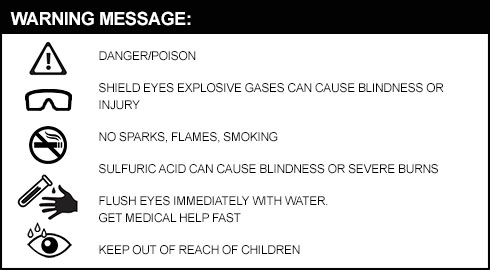
- Always wear proper eye, face and hand protection when working with batteries
- Never lean over a battery while boosting, testing or charging
- Exercise caution when working with metallic tools or conductors to prevent short circuits and arcing
- Keep terminals protected to prevent accidental shorting
- Replace any battery that has signs of damage to the terminals, case or cover
- Install a battery in a ventilated area for operation and during charging
- DO NOT ADD WATER TO THE OPTIMA BATTERY
- Always use a voltage-regulated battery charger with limits set to the above ratings. Overcharging can cause the safety valves to open and battery gasses to escape, resulting in premature failure. These gasses are flammable! You cannot replace water in sealed batteries that have been overcharged. Any battery that becomes very hot or makes a hissing sound while recharging should be disconnected immediately
Download the Materials Safety Data Sheet to get information on battery content, safety and handling, and emergency measures.
-
Acid- Liquid in the electrolyte of a lead-acid battery.
Acid Stratification- When charging a traditional/flooded lead-acid cell, high-density acid is produced in the plates. This heavy acid drops as a result of gravitation to the lower part of the cell while lower density acid rises to the top of the cell. This stratification of acid can cause loss of capacity and/or battery failure. Acid stratification is a much smaller concern in AGM batteries.
Active Material- Chemically active compounds in a cell or battery that convert from one composition to another while producing current (electrical energy) or accepting current from an external circuit.
Absorbent Glass Mat (AGM)- The mat of micro glass fibers, which is used for fixing the sulfuric acid in lead accumulators.
Ampere (Amp)- The unit of measure of the electron flow, or current, through a circuit.
Ampere (Amp) Hours- The unit of measure for a battery’s electrical storage capacity. Multiply the current in amperes by the time in hours of discharge.
Battery- One or more galvanic (electrochemical) cells electrically coupled into a single unit and equipped with attachments for external electrical connections.
Battery Charger- Device supplying electrical energy to a secondary battery.
BMS (Battery Management System)- The system within a lithium battery that is intended to oversee and control battery functionality.Capacity- The ability of a fully charged battery to deliver a specified quantity of electricity at a given rate over a definite period of time.
Cell- The basic electrochemical current-producing unit in a battery consisting of a set of positive plates, negative plates, electrolyte, separators and casing. There are six cells in a 12-volt lead-acid battery and four LFP cells in a 12-volt lithium battery.
Charge Acceptance- The quantity of current in ampere hours that a battery in a defined charge state can accept at a specified temperature and charge voltage within a defined period.
Circuit- Path followed by a flow of electrons. A closed circuit is a complete path. An open circuit has a broken or disconnected path.
Cold-Cranking Amps (CCA)- Number of amperes a lead-acid battery at 0oF (-17.8oC) can deliver for 30 seconds and maintain at least 1.2 volts per cell.
Container- The polypropylene or hard rubber case that holds the plates, straps and electrolyte (or cells and BMS in a lithium battery).Corrosion- Destructive chemical reaction of a liquid electrolyte with a reactive.
Cover- The lid for the container.
Current- Flow of electricity measured in amperes.
Cycle- Charging followed by discharging, repeated at regular intervals.
Deep-Cycle Battery- Battery that provides a steady amount of current over a long period of time. It provides a surge when needed and is designed to be deeply discharged over and over again.
Discharge- Delivering current through the battery.
Deep Discharge- State in which a cell is fully discharged using low current, so that the voltage falls below the final discharging voltage.
Electrolyte- A solution of sulfuric acid and distilled water that conducts current through the movement of ions between positive and negative plates.
Grid- Lead alloy framework that supports the active material of a battery plate and conducts current.
Ground- Reference potential of a circuit. In automobile use, the result of attaching the battery cable to the body frame, which is used as a path for completing a circuit in lieu of a direct wire from a component. Today, over 99 percent of autos use the negative terminal of the battery as the ground.
Lead-Acid Battery- Battery made up of plates, lead and lead oxide (various other elements are used to change density, hardness, porosity, etc.) with a 35 percent sulfuric acid and 65 percent water solution. This solution is called an electrolyte, which causes a chemical reaction that produces electrons.
Lithium Battery- Battery made up of individually sealed lithium cells (4 cells in a 12V battery with lithium iron phosphate cells). Higher-quality lithium batteries will have an integrated battery management system (BMS), which protects from overcharge, over-discharge, over current, short circuit, over/under temperatures for the specific lithium chemistry, as well as ensuring proper cell balancing. Internal cell heaters may also be used to allow for charging in extremely cold temperatures. The processing power of the BMS may also enable additional features, such as power management, CAN, bluetooth or other communication capabilities.
Maintenance-Free Battery- Battery in which you don't have to check or refill the electrolyte levels.
Ohm- Unit for measuring electrical resistance or impedance within an electrical circuit.
OPTIMA CPR- An integrated feature on ORANGETOP powersports batteries that automatically disconnects the battery from external power draws, allowing for one more engine start
Plate - Positive- Cast metallic frame that contains the lead dioxide active material.
Plate - Negative- Cast metallic frame that contains a spongy lead active material.
POWERLINK- An external battery dongle that connects to ORANGETOP Powersports batteries and allows users to monitor state of charge with an LED display, turn the battery off from power draws and make a remote connection for charging.
PHCA (Pulse Hot Cranking Amps)- The number of amperes a lithium battery at 77°F can deliver for five seconds
Reserve Capacity Rating (RC)- Number of minutes a battery at 26.7o C/80o F can be discharged at a 25-amp rate until reaching 10.5 volts (for a 12-volt battery) and maintaining 10.5 volts for a 12-volt battery. The higher the rating, the longer your vehicle can operate should your alternator or fan belt malfunction.
Sealed Battery- Battery in which you don't have to check or refill the electrolyte levels. Leak-proof at angles over 45 degrees, also called VRLA (Valve Regulated Lead-Acid).
Separators- Porous dividers between plates that prevent physical contact.
Short Circuit- An unintended current-bypass in an electric device or wiring, generally very low in resistance and thus causing a large amount of current to flow. In a battery, a cell short circuit may be damaging enough to discharge the cell and render the battery useless.
Starting, Lighting, Ignition (SLI) Battery- Rechargeable battery that supplies electric energy to an automobile to power the starter motor, the lights and the ignition system of a vehicle’s engine.
State of Charge (SOC)- The amount of electrical energy stored in a battery at a given time expressed as a percentage of the energy when fully charged.
Terminals- Electrical connection from the battery to the external circuit. Each terminal is connected to either the first (positive) or last (negative) strap in the series connection of cells in a battery.
Valve Regulated Lead-Acid (VRLA) Battery- Battery that is sealed and maintenance-free.
Volt- Unit of measure for electrical potential.
Watt- Unit of measure for electrical power. -
If you don't have aftermarket electrical accessories in your vehicle, we recommend the REDTOP® 35. If you do have aftermarket electrical accessories, such as an audio system with amps, we recommend YELLOWTOP® D35. Both of these are top-post-only batteries.
Please note we also make a group 75/25 battery (some retailers will label it 75/35 in their system). This battery has both top and side posts and probably will not work in your vehicle. The positive and negative posts are on the wrong side for your vehicle and your cables may not reach.
Free shipping on all orders


